Evolution and Determinants of an Air Transport Network: A Case Study of the Chinese Main Air Transport Network
Abstract
1. Introduction
2. Study Area and Data
3. Methods
3.1. Network Analysis
3.2. Econometric Model
4. Results and Analysis
4.1. Network Evolution Analysis
4.1.1. Original Data Analysis
4.1.2. Overall Network Structure Analysis
4.1.3. Centrality Analysis
4.2. Impact of GDP, Tourism and HSR
5. Discussion and Conclusions
Author Contributions
Funding
Acknowledgments
Conflicts of Interest
References
- Wang, J.; Mo, H.; Wang, F.; Jin, F. Exploring the network structure and nodal centrality of China’s air transport network: A complex network approach. J. Transp. Geogr. 2011, 19, 712–721. [Google Scholar] [CrossRef]
- Jiao, J.; Wang, J.; Jin, F. Impacts of high-speed rail lines on the city network in China. J. Transp. Geogr. 2017, 60, 257–266. [Google Scholar] [CrossRef]
- Yang, H.; Dijst, M.; Witte, P.; Ginkel, H.; Wang, J. Comparing passenger flow and time schedule data to analyse High-Speed Railways and urban networks in China. Urban Stud. 2018, 56, 1267–1287. [Google Scholar] [CrossRef]
- Bagler, G. Analysis of the airport network of India as a complex weighted network. Phys. A Stat. Mech. Appl. 2008, 387, 2972–2980. [Google Scholar] [CrossRef]
- Dunn, S.; Wilkinson, S.M. Increasing the resilience of air traffic networks using a network graph theory approach. Transp. Res. Part E Logist. Transp. Rev. 2016, 90, 39–50. [Google Scholar] [CrossRef]
- Hossain, M.M.; Alam, S. A complex network approach towards modeling and analysis of the Australian Airport Network. J. Air Transp. Manag. 2017, 60, 1–9. [Google Scholar] [CrossRef]
- Jiang, X.; Wen, X.; Wu, M.; Song, M.; Tu, C. A complex network analysis approach for identifying air traffic congestion based on independent component analysis. Phys. A Stat. Mech. Appl. 2019, 523, 364–381. [Google Scholar] [CrossRef]
- Klophaus, R.; Lordan, O. Code sharing network vulnerability of global airline alliances. Transp. Res. Part A Policy Pract. 2018, 111, 1–10. [Google Scholar] [CrossRef]
- Song, M.G.; Yeo, G.T. Analysis of the Air Transport Network Characteristics of Major Airports. Asian J. Shipp. Logist. 2017, 33, 117–125. [Google Scholar] [CrossRef]
- Yang, H.; Dobruszkes, F.; Wang, J.; Dijst, M.; Witte, P. Comparing China’s urban systems in high-speed railway and airline networks. J. Transp. Geogr. 2018, 68, 233–244. [Google Scholar] [CrossRef]
- Guimerà, R.; Mossa, S.; Turtschi, A.; Amaral, L. The worldwide air transportation network: Anomalous centrality, community structure, and cities’ global roles. Proc. Natl. Acad. Sci. USA 2005, 102, 7794–7799. [Google Scholar] [CrossRef] [PubMed]
- Wandelt, S.; Sun, X. Evolution of the international air transportation country network from 2002 to 2013. Transp. Res. Part E Logist. Transp. Rev. 2015, 82, 55–78. [Google Scholar] [CrossRef]
- Guida, M.; Maria, F. Topology of the Italian airport network: A scale-free small-world network with a fractal structure? Chaos Solit. Fractals 2007, 31, 527–536. [Google Scholar] [CrossRef]
- Watts, D.J.; Strogatz, S.H. Collective dynamics of ‘small-world’ networks. Nature 1998, 393, 440–442. [Google Scholar] [CrossRef] [PubMed]
- Xu, Z.; Harriss, R. Exploring the structure of the U.S. intercity passenger air transportation network: A weighted complex network approach. GeoJournal 2008, 73, 87–102. [Google Scholar]
- Du, W.; Liang, B.; Hong, C.; Lordan, O. Analysis of the Chinese provincial air transportation network. Phys. A Stat. Mech. Appl. 2017, 465, 579–586. [Google Scholar] [CrossRef]
- Lin, J. Network analysis of China’s aviation system, statistical and spatial structure. J. Transp. Geogr. 2012, 22, 109–117. [Google Scholar] [CrossRef]
- Zhang, J.; Cao, X.; Du, W.; Cai, K. Evolution of Chinese airport network. Phys. A Stat. Mech. Appl. 2010, 389, 3922–3931. [Google Scholar] [CrossRef]
- Zhang, X.; Tang, X.; Jiang, K. Empirical Study of Chinese Airline Network Structure Based on Complex Network Theory. J. Transp. Syst. Eng. Inf. Technol. 2011, 11, 175–181. [Google Scholar]
- Azzam, M.; Klingauf, U.; Zock, A. The accelerated growth of the worldwide air transportation network. Eur. Phys. J. Spec. Top. 2013, 212, 35–48. [Google Scholar] [CrossRef]
- Gautreau, A.; Barrat, A.; Barthlemy, M. Microdynamics in stationary complex networks. Proc. Natl. Acad. Sci. USA 2009, 106, 8847–8852. [Google Scholar] [CrossRef]
- Jia, T.; Qin, K.; Shan, J. An exploratory analysis on the evolution of the US airport network. Phys. A Stat. Mech. Appl. 2014, 413, 266–279. [Google Scholar] [CrossRef]
- Lin, J.; Ban, Y. The evolving network structure of US airline system during 1990–2010. Phys. A Stat. Mech. Appl. 2014, 410, 302–312. [Google Scholar] [CrossRef]
- Burghouwt, G.; Hakfoort, J. The evolution of the European aviation network. J. Air Transp. Manag. 2001, 7, 311–318. [Google Scholar] [CrossRef]
- Papatheodorou, A.; Arvanitis, P. Spatial evolution of airport traffic and air transport liberalisation: The case of Greece. J. Transp. Geogr. 2009, 17, 402–412. [Google Scholar] [CrossRef]
- Jimenez, E.; Claro, J.; de Sousa, J.P. Spatial and commercial evolution of aviation networks: A case study in mainland Portugal. J. Transp. Geogr. 2012, 24, 383–395. [Google Scholar] [CrossRef]
- Wang, J.; Mo, H.; Wang, F. Evolution of air transport network of China 1930–2012. J. Transp. Geogr. 2014, 40, 145–158. [Google Scholar] [CrossRef]
- Jin, F.; Wang, F.; Liu, Y. Geographic Patterns of Air Passenger Transport in China 1980–1998: Imprints of Economic Growth, Regional Inequality, and Network Development. Prof. Geogr. 2004, 56, 471–487. [Google Scholar]
- Dargay, J.M.; Clark, S. The determinants of long distance travel in Great Britain. Transp. Res. Part A Policy Pract. 2012, 46, 576–587. [Google Scholar] [CrossRef]
- Lee, J.; Yoo, K.; Song, K. A study on travelers’ transport mode choice behavior using the mixed logit model: A case study of the Seoul-Jeju route. J. Air Transp. Manag. 2016, 56, 131–137. [Google Scholar] [CrossRef]
- Park, Y.; Ha, H.K. Analysis of the impact of high-speed railroad service on air transport demand. Transp. Res. Part E Logist. Transp. Rev. 2006, 42, 95–104. [Google Scholar] [CrossRef]
- Román, C.; Martín, J.C.; Espino, R.; Cherchi, E.; Ortúzar, J.D.D.; Rizzi, L.I.; González, R.M.; Amador, F.J. Valuation of travel time savings for intercity travel: The Madrid-Barcelona corridor. Transp. Policy 2014, 36, 105–117. [Google Scholar] [CrossRef]
- Socorro, M.P.; Viecens, M.F. The effects of airline and high speed train integration. Transp. Res. Part A Policy Pract. 2013, 49, 160–177. [Google Scholar] [CrossRef]
- Kim, J.J.; Kim, I. Entrepreneurial Marketing and Airline-Cause Sponsorship Congruence: Passenger Sponsorship Response to US-Based Full-Service Airlines. Sustainability 2018, 7, 2359. [Google Scholar] [CrossRef]
- Wang, Y.; Yan, X.; Zhou, Y. Influencing Mechanism of Potential Factors on Passengers’ Long-Distance Travel Mode Choices Based on Structural Equation Modeling. Sustainability 2017, 11, 1943. [Google Scholar] [CrossRef]
- Givoni, M.; Banister, D. Airline and railway integration. Transp. Policy 2006, 13, 386–397. [Google Scholar] [CrossRef]
- Jiang, C.; Zhang, A. Effects of high-speed rail and airline cooperation under hub airport capacity constraint. Transp. Res. Part B Methodol. 2014, 60, 33–49. [Google Scholar] [CrossRef]
- Jiang, C.; D’Alfonso, T.; Wan, Y. Air-rail cooperation: Partnership level, market structure and welfare implications. Transp. Res. Part B Methodol. 2017, 104, 461–482. [Google Scholar] [CrossRef]
- Xia, W.; Jiang, C.; Wang, K.; Zhang, A. Air-rail revenue sharing in a multi-airport system: Effects on traffic and social welfare. Transp. Res. Part B Methodol. 2019, 121, 304–319. [Google Scholar] [CrossRef]
- Dobruszkes, F. High-speed rail and air transport competition in Western Europe: A supply-oriented perspective. Transp. Policy 2011, 18, 870–879. [Google Scholar] [CrossRef]
- Dobruszkes, F.; Dehon, C.; Givoni, M. Does European high-speed rail affect the current level of air services? An EU-wide analysis. Transp. Res. Part A Policy Pract. 2014, 69, 461–475. [Google Scholar] [CrossRef]
- Yang, H.; Burghouwt, G.; Wang, J.; Boonekamp, T.; Dijst, M. The implications of high-speed railways on air passenger flows in China. Appl. Geogr. 2018, 97, 1–9. [Google Scholar] [CrossRef]
- Albalate, D.; Bel, G.; Fageda, X. Competition and cooperation between high-speed rail and air transportation services in Europe. J. Transp. Geogr. 2015, 42, 166–174. [Google Scholar] [CrossRef]
- Wan, Y.; Ha, H.; Yoshida, Y.; Zhang, A. Airlines’ reaction to high-speed rail entries: Empirical study of the Northeast Asian market. Transp. Res. Part A Policy Pract. 2016, 94, 532–557. [Google Scholar] [CrossRef]
- Zhang, R.; Johnson, D.; Zhao, W.; Nash, C. Competition of airline and high-speed rail in terms of price and frequency: Empirical study from China. Transp. Policy 2019, 78, 8–18. [Google Scholar] [CrossRef]
- Bergantino, A.S.; Capozza, C. One price for all? Price discrimination and market captivity: Evidence from the Italian city-pair markets. Transp. Res. Part A Policy Pract. 2015, 75, 231–244. [Google Scholar] [CrossRef]
- Bergantino, A.S.; Capozza, C.; Capurso, M. The impact of open access on intra- and inter-modal rail competition. A national level analysis in Italy. Transp. Policy 2015, 39, 77–86. [Google Scholar] [CrossRef]
- Capozza, C. The effect of rail travel time on airline fares: First evidence from the Italian passenger market. Econ. Transp. 2016, 6, 18–24. [Google Scholar] [CrossRef]
- Yang, H.; Zhang, A. Effects of high-speed rail and air transport competition on prices, profits and welfare. Transp. Res. Part B Methodol. 2012, 46, 1322–1333. [Google Scholar] [CrossRef]
- Wang, J.; Bonilla, D.; Banister, D. Air deregulation in China and its impact on airline competition 1994–2012. J. Transp. Geogr. 2016, 50, 12–23. [Google Scholar] [CrossRef]
- Li, W.; Cai, X. Statistical analysis of airport network of China. Phys. Rev. E Stat. Nonlinear Soft Matter Phys. 2004, 69, 46106. [Google Scholar] [CrossRef]
- IATA. IATA Annual Review 2017; IATA: Montreal, QC, Canada, 2017; p. 12. [Google Scholar]
- Fu, X.; Zhang, A.; Lei, Z. Will China’s airline industry survive the entry of high-speed rail? Res. Transp. Econ. 2012, 35, 13–25. [Google Scholar] [CrossRef]
- Su, M.; Luan, W.; Yuan, L.; Zhang, R.; Zhang, Z. Sustainability Development of High-Speed Rail and Airline—Understanding Passengers’ Preferences: A Case Study of the Beijing–Shanghai Corridor. Sustainability 2019, 11, 1352. [Google Scholar] [CrossRef]
- Boorman, S.A.; White, H.C. Social Structure from Multiple Networks. II. Role Structures. Am. J. Sociol. 1976, 81, 1384–1446. [Google Scholar] [CrossRef]
- Barabási, A.; Albert, R. Emergence of Scaling in Random Networks. Science 1999, 286, 509–512. [Google Scholar] [PubMed]
- Freeman, L.C. A Set of Measures of Centrality Based on Betweenness. Sociometry 1977, 40, 35–41. [Google Scholar] [CrossRef]
- Freeman, L.C. Centrality in social networks conceptual clarification. Soc. Netw. 1978, 1, 215–239. [Google Scholar] [CrossRef]
- Bagler, G. Complex Network view of performance and risks on Airport Networks. arXiv 2008, arXiv:0805.0924. [Google Scholar]
- Zhang, Q.; Yang, H.; Wang, Q.; Zhang, A. Market power and its determinants of the Chinese airline industry. Transp. Res. Part A Policy Pract. 2014, 64, 1–13. [Google Scholar] [CrossRef]
- Zhang, F.; Graham, D.J.; Wong, M.S.C. Quantifying the substitutability and complementarity between high-speed rail and air transport. Transp. Res. Part A Policy Pract. 2018, 118, 191–215. [Google Scholar] [CrossRef]
- Su, M.; Luan, W.; Sun, T. Effect of High-speed Rail Competition on Airlines’ Intertemporal Price Strategies. J. Air Transp. Manag. 2019, 101694. [Google Scholar]
- Fageda, X.; Villadangos, L.F. Triggering competition in the Spanish airline market: The role of airport capacity and low-cost carriers. J. Air Transp. Manag. 2009, 15, 36–40. [Google Scholar] [CrossRef]
- Zhang, Q.; Yang, H.; Wang, Q. Impact of high-speed rail on China’s Big Three airlines. Transp. Res. Part A Policy Pract. 2017, 98, 77–85. [Google Scholar] [CrossRef]
- Yuan, Z.; Wei, F. Research on optimal intertemporal pricing of airline tickets. China Ind. Econ. 2014, 7, 148–160. [Google Scholar]
- Costa, L.; Rodrigues, F.; Travieso, G.; Boas, P. Characterization of complex networks: A survey of measurements. Adv. Phys. 2007, 56, 167–242. [Google Scholar] [CrossRef]

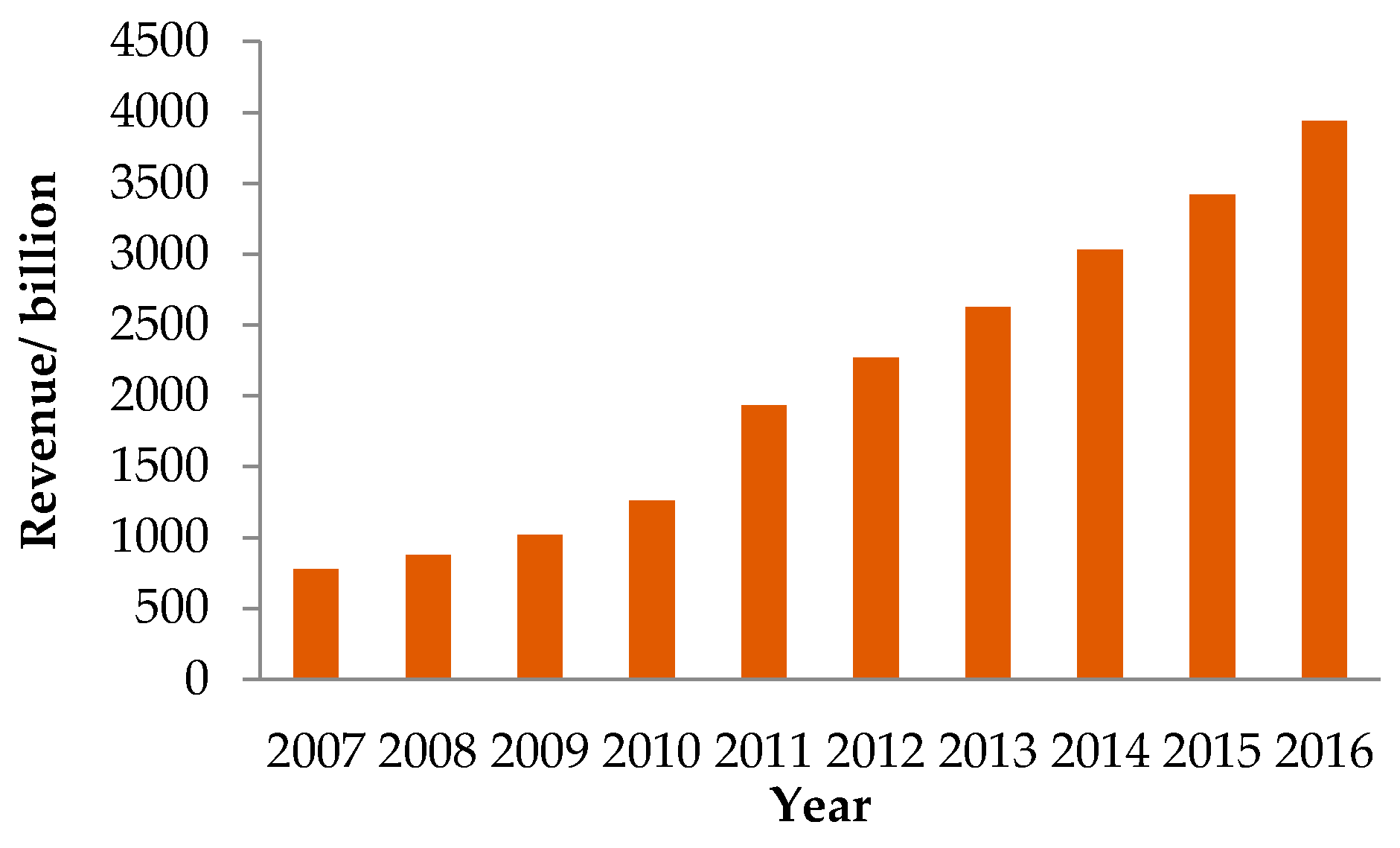
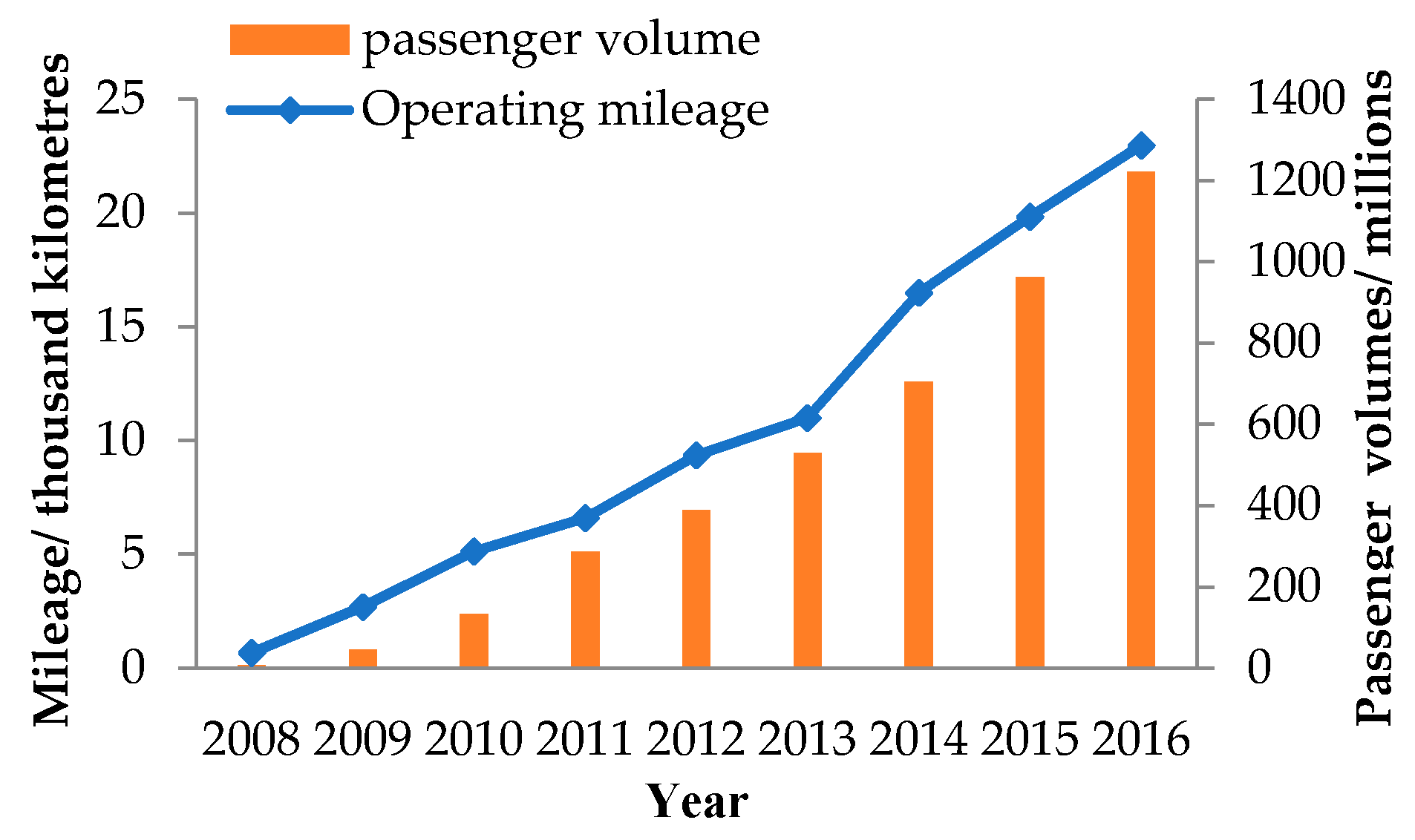


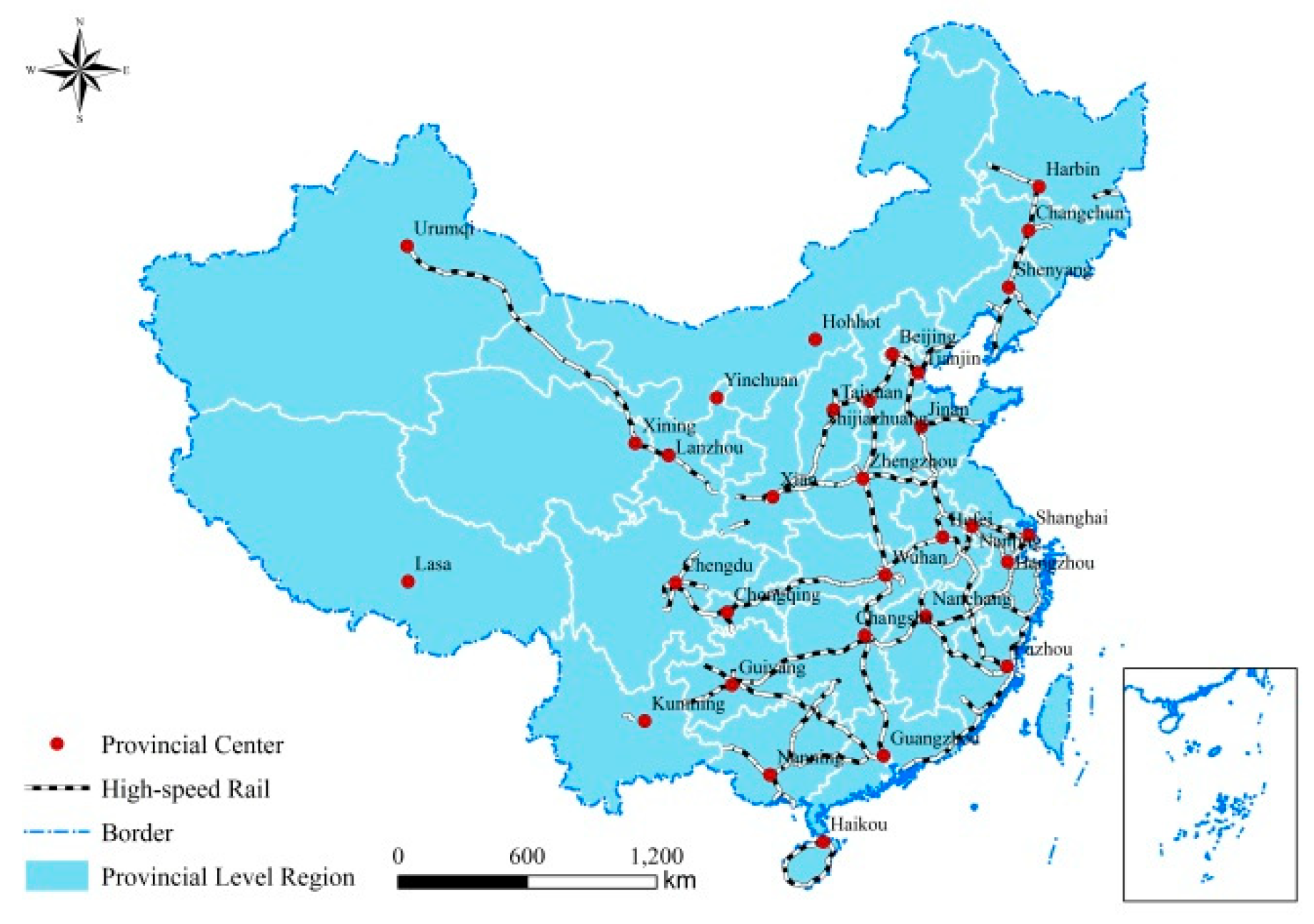

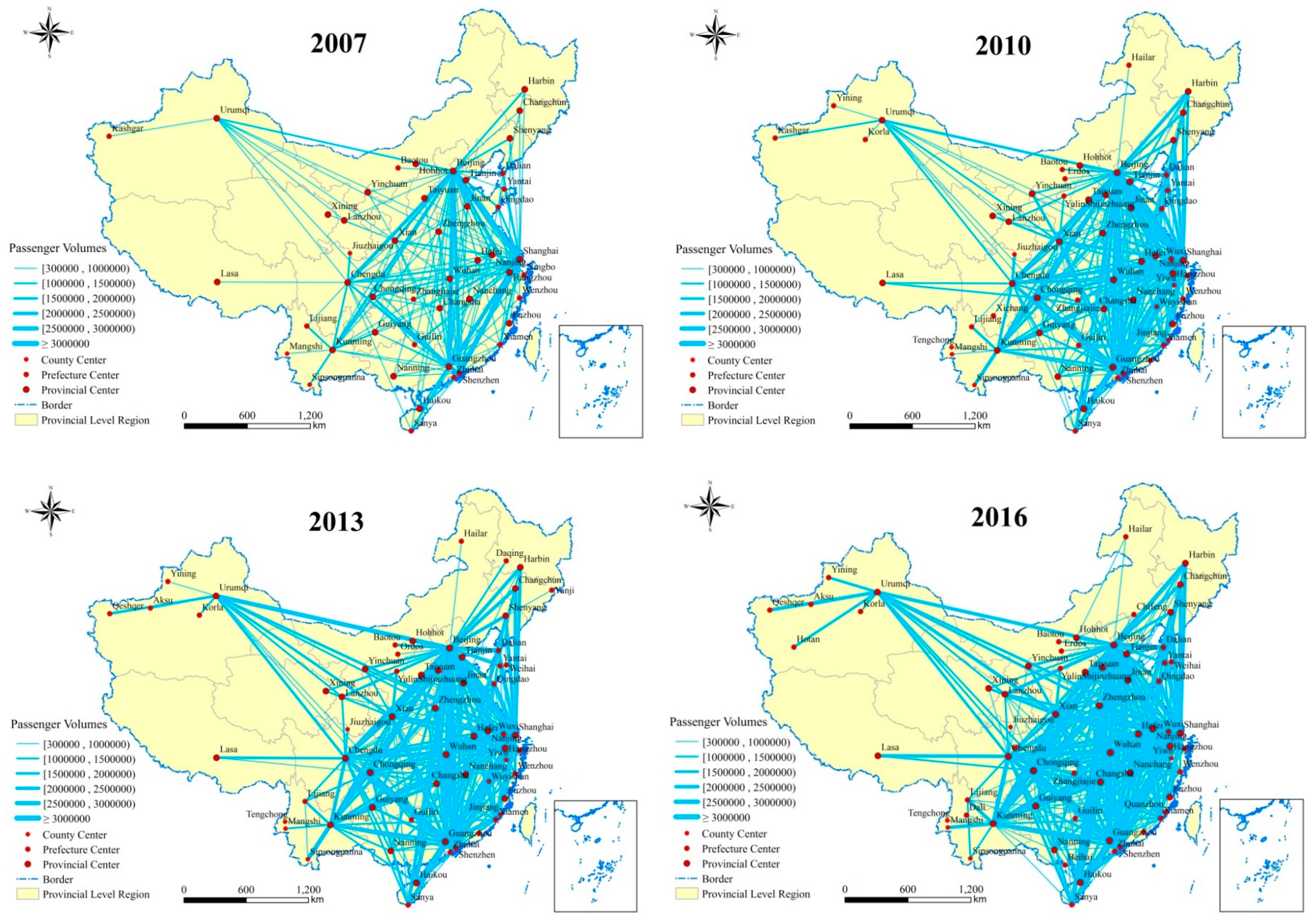
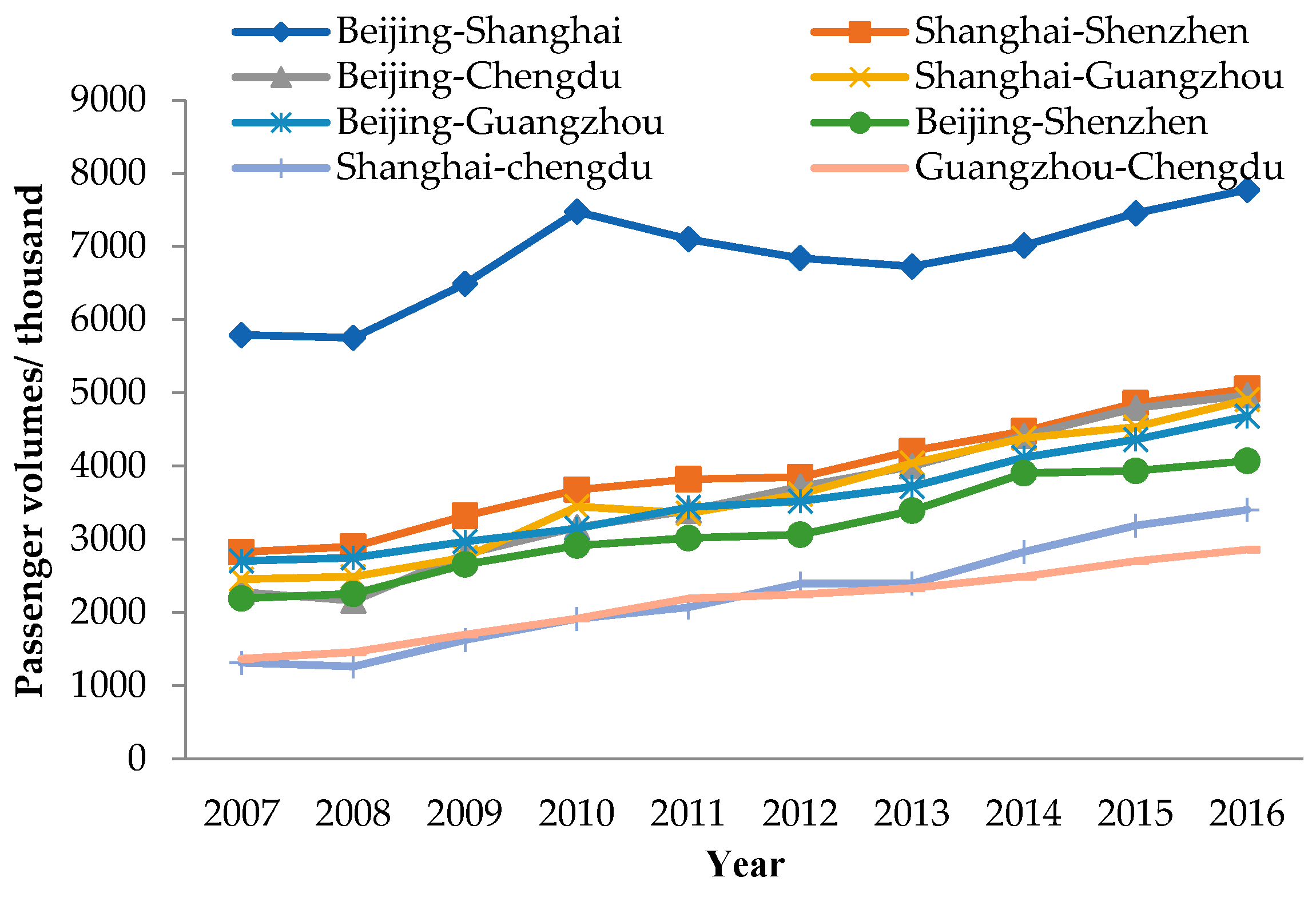
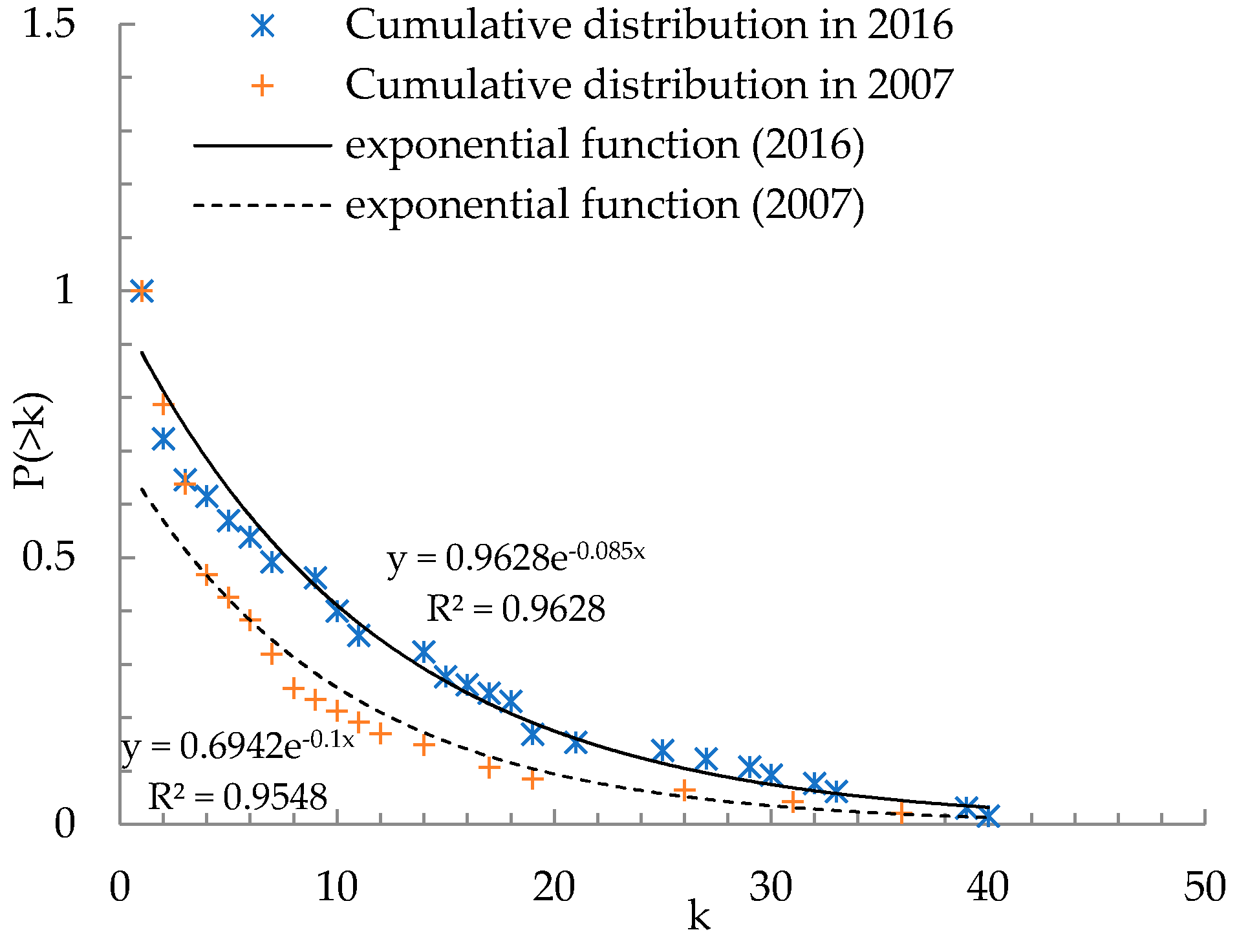
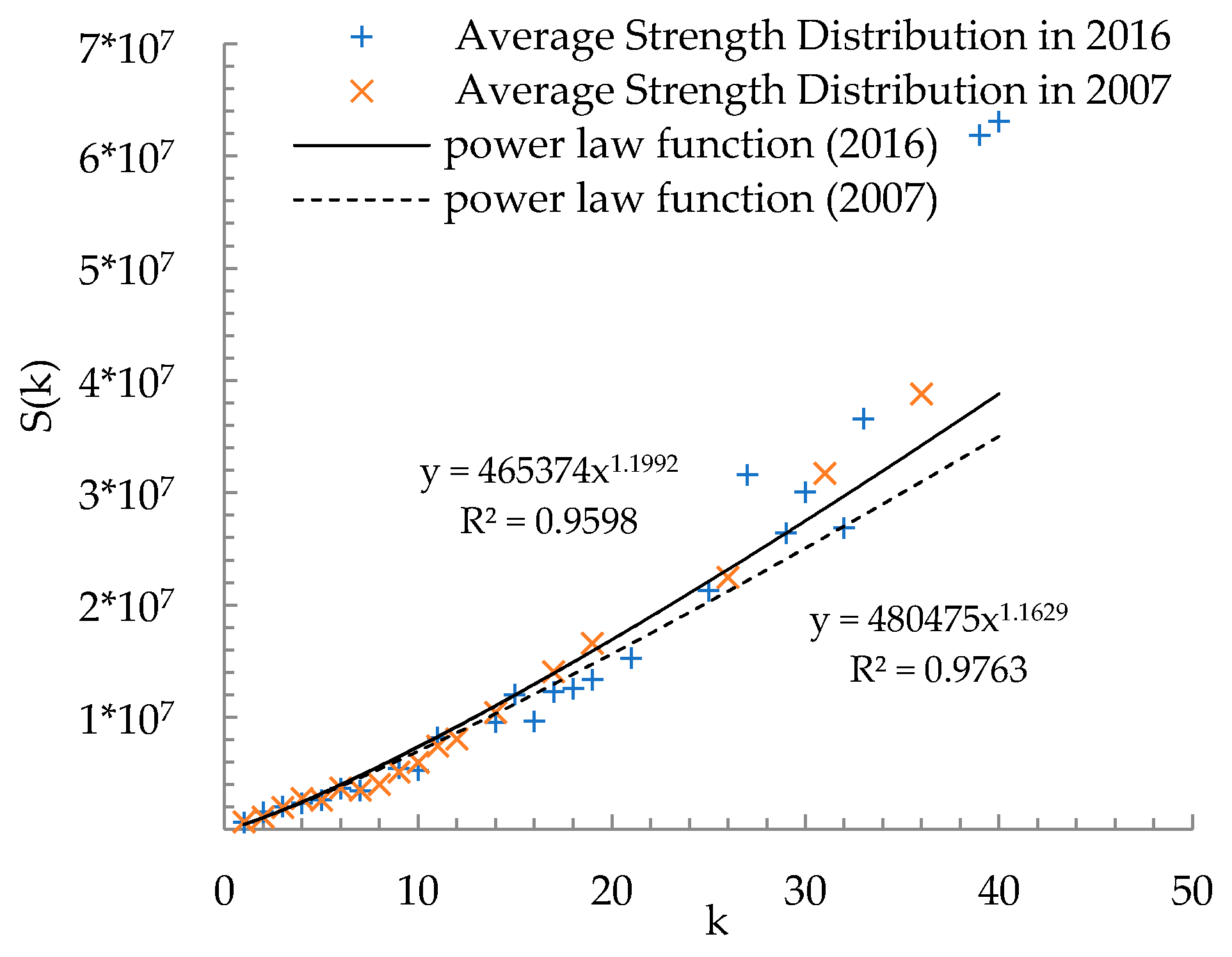
| Measure | Symbol or Equation | General Implication |
|---|---|---|
| Overall network structure | ||
| Network density | Network density D is the ratio of the actual number of edges to the maximum number of containable edges in the network. Network density measures the interconnections among nodes and reflects the overall distribution and tightness of the entire network. | |
| Average degree | Degree is the number of edges connected by node [56]. Usually, the higher the degree of a node, the greater the role of the node in the network [57,58]. The average degree is the average of the sum of all nodes’ degrees, that is, the average number of edges connected by each node in the network. | |
| Cumulative degree distribution | Degree distribution ( is the number of nodes whose degree is ) is the frequency distribution of node degrees. It can be used to analyze the changing rules of nodes from a statistical viewpoint. The cumulative degree distribution is the sum of , where . It is an important index to measure the type of a real network. | |
| Average path length | Average path length measures the average number of shortest path edges between all pairs of nodes [14]. It reflects the compactness and accessibility of the network, and is an important index to measure the performance of a network [59]. | |
| Average clustering coefficient | Clustering coefficient reflects the local cohesion of the network and the transfer function of a node. Average clustering coefficient is the average of the clustering coefficients of all nodes, reflecting the aggregation degree of the entire network. The average clustering coefficient of a real network is usually larger than that of random networks of the same size. | |
| Relationship between average strength and degree | Node strength is the sum of the weights of all connected edges of a node . is the distribution of the average strength (i.e., average node strength with the same degree) with nodes’ degrees. It is used to analyze the relationship between a node‘s degree and strength. | |
| Centrality | ||
| Normalized degree centrality | To eliminate the influence of different network scales on degree centrality over time, we adopt normalized centrality. Normalized degree centrality measures the ability of communication between a single node and other nodes, which reflects the degree to which the former node is in a relative central position in the network. | |
| Normalized closeness centrality | Normalized closeness centrality examines the degree to which a node does not depend on other nodes to reach another node. If the distance between a node and all other nodes is short, then the node is the center of the network. When the sum of distances tends to infinity, the value of tends to zero, that is, this node is not in a central position and its normalized closeness centrality is very small. | |
| Normalized betweenness centrality | Normalized betweenness centrality is a control index, which reflects that a node becomes an intermediary between other nodes. is the geodesic distance path between node and nodes and , the geodesic distance path between node and node , through node . | |
| Year | |||||||||||
|---|---|---|---|---|---|---|---|---|---|---|---|
| 2007 | 0.144 | 6.64 | 2.06 | 0.77 | 0.694 | −0.100 | 0.955 | 4.805 | 1.163 | 0.976 | 0.158 |
| 2008 | 0.145 | 6.94 | 2.09 | 0.75 | 0.750 | −0.100 | 0.948 | 4.715 | 1.166 | 0.986 | 0.155 |
| 2009 | 0.137 | 7.42 | 2.11 | 0.75 | 0.741 | −0.093 | 0.980 | 4.962 | 1.165 | 0.977 | 0.169 |
| 2010 | 0.135 | 7.97 | 2.15 | 0.71 | 0.785 | −0.093 | 0.984 | 4.428 | 1.201 | 0.973 | 0.135 |
| 2011 | 0.129 | 7.49 | 2.11 | 0.73 | 0.699 | −0.088 | 0.971 | 4.689 | 1.197 | 0.981 | 0.130 |
| 2012 | 0.139 | 7.93 | 2.12 | 0.71 | 0.773 | −0.091 | 0.968 | 5.081 | 1.166 | 0.977 | 0.131 |
| 2013 | 0.132 | 8.03 | 2.13 | 0.72 | 0.762 | −0.088 | 0.978 | 4.739 | 1.188 | 0.973 | 0.137 |
| 2014 | 0.148 | 9.03 | 2.13 | 0.68 | 0.905 | −0.091 | 0.988 | 4.532 | 1.201 | 0.962 | 0.142 |
| 2015 | 0.144 | 9.20 | 2.14 | 0.69 | 0.888 | −0.089 | 0.977 | 4.415 | 1.217 | 0.951 | 0.146 |
| 2016 | 0.160 | 10.25 | 2.11 | 0.68 | 0.963 | −0.085 | 0.963 | 4.654 | 1.199 | 0.960 | 0.158 |
| Shortest Path | 2007 | 2016 | Transfer Times | ||||
|---|---|---|---|---|---|---|---|
| Frequency | Percentage (%) | Cumulative Percentage (%) | Frequency | Percentage (%) | Cumulative Percentage (%) | ||
| 1 | 312 | 14.43 | 14.43 | 666 | 16.01 | 16.01 | 0 |
| 2 | 1406 | 65.03 | 79.46 | 2410 | 57.93 | 73.94 | 1 |
| 3 | 440 | 20.35 | 99.81 | 1044 | 25.10 | 99.04 | 2 |
| 4 | 4 | 0.19 | 100.00 | 40 | 0.96 | 100 | 3 |
| City | Category | 2007 | 2008 | 2009 | 2010 | 2011 | 2012 | 2013 | 2014 | 2015 | 2016 |
|---|---|---|---|---|---|---|---|---|---|---|---|
| Beijing | Strength | 38.78 | 41.07 | 49.74 | 54.56 | 57.27 | 58.01 | 59.68 | 60.06 | 61.29 | 63.09 |
| Degree | 36 | 37 | 40 | 41 | 41 | 40 | 43 | 41 | 41 | 40 | |
| Shanghai | Strength | 31.70 | 32.08 | 38.32 | 47.81 | 48.33 | 49.21 | 51.06 | 54.78 | 59.05 | 61.86 |
| Degree | 31 | 30 | 32 | 36 | 37 | 35 | 35 | 36 | 36 | 39 | |
| Guangzhou | Strength | 22.47 | 25.97 | 29.05 | 31.50 | 33.27 | 34.81 | 36.82 | 37.97 | 37.20 | 39.19 |
| Degree | 26 | 30 | 31 | 32 | 33 | 35 | 35 | 34 | 33 | 33 | |
| Chengdu | Strength | 14.05 | 12.96 | 18.26 | 20.65 | 22.25 | 23.30 | 25.00 | 28.13 | 31.53 | 33.97 |
| Degree | 17 | 17 | 21 | 23 | 25 | 26 | 28 | 30 | 32 | 33 | |
| Shenzhen | Strength | 16.58 | 17.55 | 20.13 | 22.37 | 23.32 | 22.79 | 24.54 | 27.93 | 29.79 | 31.60 |
| Degree | 19 | 21 | 23 | 25 | 27 | 24 | 24 | 27 | 25 | 27 | |
| Kunming | Strength | 11.84 | 11.62 | 14.69 | 15.69 | 15.02 | 15.21 | 20.01 | 21.38 | 26.61 | 30.07 |
| Degree | 14 | 13 | 16 | 19 | 19 | 20 | 24 | 24 | 29 | 30 | |
| Chongqing | Strength | 7.46 | 8.63 | 10.89 | 12.61 | 13.13 | 15.03 | 16.64 | 20.04 | 22.34 | 26.86 |
| Degree | 11 | 12 | 14 | 17 | 18 | 21 | 20 | 25 | 26 | 32 | |
| Xi’an | Strength | 8.99 | 9.64 | 13.98 | 15.77 | 14.43 | 15.64 | 16.69 | 19.25 | 23.38 | 26.42 |
| Degree | 14 | 15 | 21 | 20 | 19 | 20 | 21 | 23 | 29 | 29 | |
| Hangzhou | Strength | 8.08 | 9.32 | 12.28 | 13.60 | 11.67 | 12.42 | 14.67 | 16.91 | 19.20 | 21.27 |
| Degree | 12 | 13 | 18 | 18 | 15 | 16 | 19 | 20 | 23 | 25 | |
| Nanjing | Strength | 4.30 | 5.55 | 7.47 | 9.31 | 7.47 | 7.72 | 8.36 | 9.74 | 12.36 | 15.28 |
| Degree | 7 | 10 | 12 | 14 | 10 | 12 | 13 | 16 | 19 | 21 | |
| Xiamen | Strength | 4.28 | 5.07 | 6.20 | 8.92 | 9.28 | 9.95 | 10.81 | 12.04 | 12.24 | 13.58 |
| Degree | 6 | 8 | 8 | 13 | 13 | 14 | 14 | 17 | 16 | 18 | |
| Zhengzhou | Strength | 3.38 | 3.38 | 4.90 | 6.58 | 6.73 | 7.14 | 7.43 | 8.89 | 9.53 | 13.35 |
| Degree | 7 | 6 | 9 | 11 | 12 | 12 | 12 | 13 | 13 | 19 | |
| Urumqi | Strength | 4.00 | 2.98 | 3.69 | 6.71 | 5.25 | 7.26 | 9.24 | 10.57 | 12.22 | 12.83 |
| Degree | 8 | 5 | 6 | 11 | 7 | 10 | 12 | 13 | 14 | 14 | |
| Changsha | Strength | 5.11 | 6.36 | 9.40 | 11.40 | 7.74 | 7.91 | 8.88 | 10.76 | 10.49 | 12.64 |
| Degree | 9 | 12 | 15 | 19 | 13 | 12 | 13 | 16 | 15 | 18 | |
| Haikou | Strength | 3.81 | 4.33 | 4.48 | 4.90 | 6.24 | 6.78 | 7.13 | 8.84 | 10.74 | 12.28 |
| Degree | 4 | 5 | 5 | 6 | 9 | 11 | 11 | 13 | 16 | 17 | |
| Qingdao | Strength | 4.08 | 4.95 | 7.37 | 8.57 | 6.08 | 6.42 | 7.20 | 8.67 | 10.07 | 12.03 |
| Degree | 6 | 8 | 13 | 14 | 9 | 10 | 11 | 13 | 15 | 18 | |
| Sanya | Strength | 3.06 | 3.62 | 5.42 | 6.12 | 6.83 | 7.14 | 8.33 | 10.09 | 11.13 | 12.00 |
| Degree | 5 | 6 | 9 | 9 | 10 | 10 | 11 | 13 | 14 | 15 | |
| Wuhan | Strength | 5.97 | 7.22 | 8.68 | 9.01 | 7.13 | 8.15 | 8.46 | 9.71 | 11.12 | 11.99 |
| Degree | 10 | 12 | 12 | 13 | 11 | 13 | 13 | 16 | 18 | 18 | |
| Guiyang | Strength | 2.72 | 2.49 | 4.18 | 4.57 | 3.65 | 4.44 | 6.13 | 8.13 | 7.81 | 9.66 |
| Degree | 6 | 5 | 8 | 8 | 5 | 6 | 10 | 14 | 13 | 16 | |
| Tianjin | Strength | 1.19 | 2.14 | 2.80 | 3.71 | 3.81 | 3.54 | 4.23 | 6.12 | 7.48 | 8.99 |
| Degree | 2 | 4 | 5 | 6 | 7 | 6 | 7 | 12 | 13 | 14 |
| Rank | 2007 | 2016 | ||||||||||
|---|---|---|---|---|---|---|---|---|---|---|---|---|
| CD(vi) | CC(vi) | CB(vi) | CD(vi) | CC(vi) | CB(vi) | |||||||
| City | Value | City | Value | City | Value | City | Value | City | Value | City | Value | |
| 1 | Beijing | 0.783 | Beijing | 0.821 | Beijing | 0.346 | Beijing | 0.625 | Beijing | 0.727 | Shanghai | 0.229 |
| 2 | Shanghai | 0.674 | Shanghai | 0.754 | Shanghai | 0.248 | Shanghai | 0.609 | Shanghai | 0.719 | Beijing | 0.213 |
| 3 | Guangzhou | 0.565 | Guangzhou | 0.697 | Chengdu | 0.120 | Guangzhou | 0.516 | Guangzhou | 0.674 | Urumqi | 0.152 |
| 4 | Shenzhen | 0.413 | Shenzhen | 0.622 | Guangzhou | 0.118 | Chengdu | 0.516 | Chengdu | 0.674 | Kunming | 0.132 |
| 5 | Chengdu | 0.370 | Chengdu | 0.613 | Kunming | 0.106 | Chongqing | 0.500 | Chongqing | 0.660 | Chengdu | 0.097 |
| 6 | Xi’an | 0.304 | Xi’an | 0.590 | Xi’an | 0.065 | Kunming | 0.469 | Xi’an | 0.646 | Guangzhou | 0.083 |
| 7 | Kunming | 0.304 | Kunming | 0.582 | Urumqi | 0.047 | Xi’an | 0.453 | Kunming | 0.621 | Xi’an | 0.065 |
| 8 | Hangzhou | 0.261 | Wuhan | 0.554 | Shenzhen | 0.033 | Shenzhen | 0.422 | Shenzhen | 0.598 | Chongqing | 0.061 |
| 9 | Chongqing | 0.239 | Chongqing | 0.548 | Hangzhou | 0.011 | Hangzhou | 0.391 | Wuhan | 0.582 | Shenzhen | 0.022 |
| 10 | Wuhan | 0.217 | Hangzhou | 0.541 | Chongqing | 0.004 | Nanjing | 0.328 | Hangzhou | 0.566 | Hangzhou | 0.015 |
| 11 | Changsha | 0.196 | Changsha | 0.541 | Changsha | 0.003 | Zhengzhou | 0.299 | Zhengzhou | 0.561 | Zhengzhou | 0.014 |
| 12 | Urumqi | 0.174 | Urumqi | 0.535 | Zhengzhou | 0.002 | Changsha | 0.281 | Qingdao | 0.557 | Nanjing | 0.010 |
| 13 | Guilin | 0.152 | Zhengzhou | 0.523 | Nanjing | 0.001 | Qingdao | 0.281 | Xiamen | 0.557 | Wuhan | 0.008 |
| 14 | Nanjing | 0.152 | Guiyang | 0.523 | Xiamen | 0.001 | Wuhan | 0.281 | Changsha | 0.552 | Qingdao | 0.007 |
| 15 | Zhengzhou | 0.152 | Nanjing | 0.505 | Guilin | 0.000 | Xiamen | 0.281 | Haikou | 0.552 | Changsha | 0.005 |
| 16 | Guiyang | 0.130 | Guilin | 0.505 | Shenyang | 0.000 | Haikou | 0.266 | Nanjing | 0.547 | Xiamen | 0.004 |
| 17 | Qingdao | 0.130 | Jinan | 0.505 | Guiyang | 0.000 | Guiyang | 0.250 | Sanya | 0.542 | Guiyang | 0.004 |
| 18 | Xiamen | 0.130 | Xiamen | 0.495 | Jinan | 0.000 | Sanya | 0.234 | Urumqi | 0.542 | Harbin | 0.004 |
| 19 | Jinan | 0.109 | Sanya | 0.495 | Sanya | 0.000 | Nanning | 0.219 | Guiyang | 0.533 | Lijiang | 0.004 |
| 20 | Sanya | 0.109 | Qingdao | 0.495 | Haikou | 0.000 | Tianjin/Urumqi | 0.219 | Nanjing | 0.533 | Hohhot | 0.003 |
| Passenger Volume | Coef. | Robust Std. err. | t-Value | p-Value |
|---|---|---|---|---|
| HSR | −14.973 *** | 3.329 | −4.50 | 0.000 |
| GDP | 1.877 *** | 0.206 | 9.11 | 0.000 |
| Tourism | 1.676 *** | 0.445 | 3.77 | 0.000 |
| Population | 4.937 *** | 1.417 | 3.48 | 0.001 |
| Constant | 44.175 *** | 2.349 | 18.80 | 0.000 |
| R-squared | 0.436 | |||
| Observations | 2180 | |||
| Conditional Fixed-Effects Logistic Regression | Average Marginal Effects | |||||||
|---|---|---|---|---|---|---|---|---|
| Route | Coef. | Bootstrap Std. err. | z | P>|z| | dy/dx | Delta-Method Std. err. | z | P>|z| |
| HSR | −2.747 *** | 0.576 | −4.77 | 0.000 | −0.037 | 0.015 | −2.500 | 0.013 |
| GDP | 0.153 * | 0.083 | 1.85 | 0.065 | 0.002 | 0.001 | 1.860 | 0.063 |
| Tourism | 1.106 *** | 0.172 | 6.42 | 0.000 | 0.015 | 0.006 | 2.620 | 0.009 |
| Population | 1.963 *** | 0.720 | 2.73 | 0.006 | 0.027 | 0.006 | 4.510 | 0.000 |
| Observations | 1480 | |||||||
| Pseudo r-squared | 0.406 | |||||||
© 2019 by the authors. Licensee MDPI, Basel, Switzerland. This article is an open access article distributed under the terms and conditions of the Creative Commons Attribution (CC BY) license (http://creativecommons.org/licenses/by/4.0/).
Share and Cite
Su, M.; Luan, W.; Li, Z.; Wan, S.; Zhang, Z. Evolution and Determinants of an Air Transport Network: A Case Study of the Chinese Main Air Transport Network. Sustainability 2019, 11, 3933. https://doi.org/10.3390/su11143933
Su M, Luan W, Li Z, Wan S, Zhang Z. Evolution and Determinants of an Air Transport Network: A Case Study of the Chinese Main Air Transport Network. Sustainability. 2019; 11(14):3933. https://doi.org/10.3390/su11143933
Chicago/Turabian StyleSu, Min, Weixin Luan, Zeyang Li, Shulin Wan, and Zhenchao Zhang. 2019. "Evolution and Determinants of an Air Transport Network: A Case Study of the Chinese Main Air Transport Network" Sustainability 11, no. 14: 3933. https://doi.org/10.3390/su11143933
APA StyleSu, M., Luan, W., Li, Z., Wan, S., & Zhang, Z. (2019). Evolution and Determinants of an Air Transport Network: A Case Study of the Chinese Main Air Transport Network. Sustainability, 11(14), 3933. https://doi.org/10.3390/su11143933






